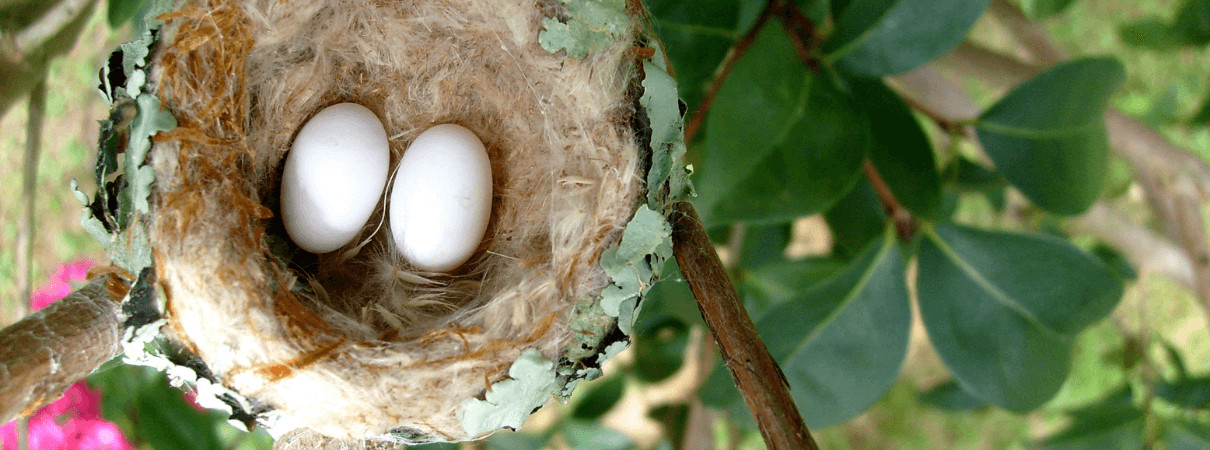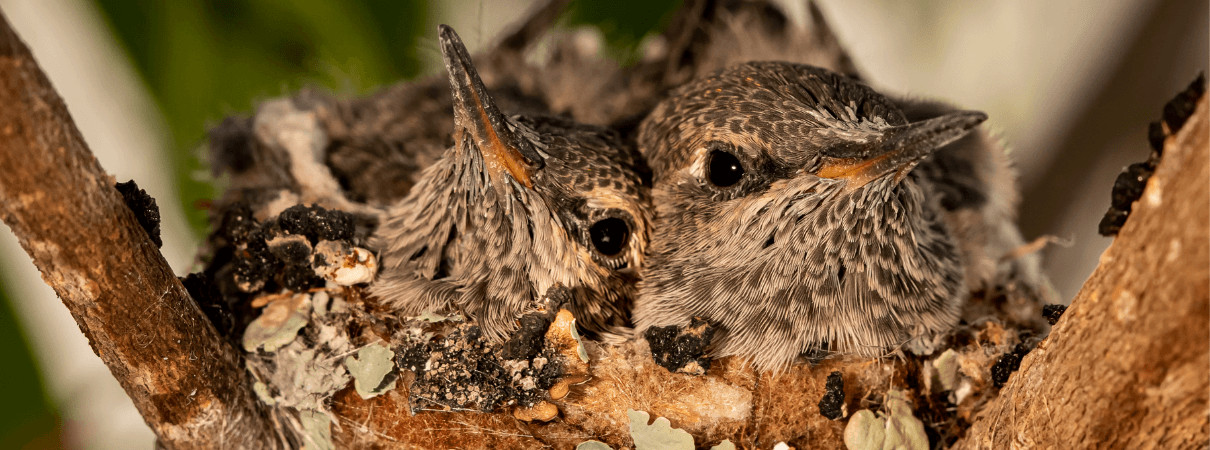Each spring, the vibrant shimmer of hummingbirds signals their return to our gardens, parks, and farms. These dazzling birds, though small, bring an undeniable energy and beauty to any outdoor space. Depending on your location, you might spot different hummingbird species, each adding a unique splash of color to the landscape. However, despite their familiarity, the nesting habits of hummingbirds often remain shrouded in mystery. Their nests are masterpieces of camouflage, so expertly hidden that they can be virtually invisible, even when you are actively searching.
To illuminate the fascinating world of hummingbird breeding, we’ve compiled an in-depth guide to answer your questions. If you’ve ever wondered about the minuscule size of hummingbird nests, the time of year these delicate birds construct their homes, and the telltale signs to look for, then keep reading to discover the secrets of hummingbird nesting.
Nesting Preferences: Location, Location, Location
Hummingbirds exhibit discerning taste when it comes to choosing a nesting site. While some species, notably the Ruby-throated Hummingbird, have shown remarkable adaptability to urban environments, occasionally nesting on wires, plant hangers, and even other human-made structures, the majority still favor the protective embrace of deciduous trees, particularly those near water sources. The dense foliage of trees provides crucial shelter for both parent hummingbirds and their vulnerable chicks, offering concealment from predators and the elements. Proximity to water is also vital, helping to moderate the temperature around the nest, especially in warmer climates. Furthermore, hummingbirds need consistent access to food sources, primarily nectar-rich flowering plants. This is another key reason why habitats near water, which often support a greater abundance of plant life, are so attractive to hummingbirds, especially in drier regions.
Unlike larger birds that might nest in the sturdy crooks of major branches, hummingbirds typically select more slender, horizontal branches for their nests. These are often positioned about a foot away from the main tree trunk, frequently in a fork or where smaller branches diverge. This strategic placement offers both support and enhanced camouflage within the tree’s structure.
Attracting Hummingbirds to Nest in Your Yard
While traditional birdhouses are not suitable for hummingbirds, as they prefer to build their own nests, you can still create a welcoming environment to encourage them to nest in your yard. Several effective strategies can make your garden a hummingbird nesting haven. Planting or maintaining a variety of native flowering plants that are rich in nectar is paramount. These plants provide the essential food source that attracts hummingbirds and sustains them throughout the breeding season. Ensuring a reliable source of fresh water, such as a birdbath or a gentle fountain, is also beneficial. Crucially, it’s vital to avoid using pesticides and other chemicals that can harm not only hummingbirds directly but also the insects that form a critical part of their diet, especially for protein during nesting season. Well-maintained hummingbird feeders, filled with a simple sugar-water solution, can further supplement their natural food sources and make your property even more appealing.
The Miniature Marvel: Size of a Hummingbird Nest
Prepare to be amazed by the diminutive size of a hummingbird nest. On average, these nests measure just a little over one inch in diameter! However, the exact size can vary depending on several factors. Naturally, different hummingbird species construct nests of varying sizes; larger species tend to build slightly larger nests compared to their smaller counterparts. The materials used in construction and the specific location of the nest can also influence its final shape and dimensions. Despite their small size, these nests are incredibly sturdy and resilient, designed to protect the fragile eggs and growing chicks.
 Hummingbird Nest in Trees
Hummingbird Nest in Trees
Nest Building Materials: Nature’s Ingenuity
Hummingbirds prioritize softness and flexibility when building their nests, creating cozy and adaptable homes for their young. They utilize a remarkable array of natural materials, showcasing their ingenuity in nest construction. Like many other bird species, hummingbirds begin with a foundation of twigs and plant fibers, often using leaves as a base layer for added structure. However, hummingbirds go a step further by incorporating moss and lichen into the nest structure. These soft materials not only contribute to the nest’s cushioning but also serve as excellent camouflage, helping the nest blend seamlessly with its surroundings. But the true secret ingredient in a hummingbird nest is spider silk.
Nest Construction: A Labor of Love
The task of building a hummingbird nest falls solely upon the female hummingbird. She diligently works for up to seven days to construct her flexible, cup-shaped nest. The process begins with creating a foundational base layer of plant materials. Then, the magic of spider silk comes into play. The female hummingbird gathers spider silk and skillfully incorporates it by rolling it over the partially built structure. This spider silk acts as a natural glue, binding the nest together and securely anchoring it to the chosen branch. She meticulously inserts the silk into nooks and crevices to ensure robust attachment and structural integrity. This intricate construction process demands several hours of work each day, highlighting the dedication of the female hummingbird to creating a safe haven for her future offspring.
Nest Appearance: Masters of Disguise
Hummingbird nests are true marvels of natural camouflage. Adorned with carefully compacted green lichen, soft moss, and interwoven spider silk, a completed hummingbird nest can easily be mistaken for a natural knot on a tree branch or a slight imperfection in the bark. This remarkable resemblance to the surrounding environment is no accident. The shape, texture, and coloring of the nest are all crucial elements of its camouflage strategy, designed to effectively conceal the vulnerable hummingbird eggs and chicks from potential predators. This natural disguise is so effective that even experienced birdwatchers often struggle to spot these tiny nests.
Nesting Season: Timing Varies with Location
The time of year when hummingbirds nest and lay their eggs is not uniform across their range and is significantly influenced by geographic location and climate. In the warmer southern regions of the United States, hummingbird breeding can commence as early as March, taking advantage of the early spring blooms and milder temperatures. Conversely, in cooler, more northerly areas or high-altitude montane regions, the nesting season may be delayed, sometimes not beginning until July when warmer weather and ample food sources become available. Interestingly, some western species, such as Anna’s Hummingbird, exhibit an even more unique nesting schedule, sometimes starting to nest as early as November, coinciding with the onset of winter rains in their habitat. This adaptability in nesting timing allows hummingbirds to maximize their breeding success within diverse environments.
The Art of Finding a Hummingbird Nest (and Why You Shouldn’t Interfere)
As previously mentioned, hummingbird nests are notoriously difficult to find due to their exceptional camouflage and small size. They are masters of concealment, blending their nests seamlessly into their surroundings. The most promising places to search are on slender, forked branches of trees and within dense shrubs, where the nests are most likely to be hidden. Remember to look for anything that resembles a small, oddly shaped knot on a branch – this could very well be a hummingbird nest.
However, the most effective method for locating a hummingbird nest is often through careful observation of hummingbird behavior. From a respectful distance, you might be able to spot a female hummingbird repeatedly visiting the same specific location. This behavior, especially during nest construction, can be a strong indicator of a nearby nest. During the incubation period, female hummingbirds will only leave their nests for brief foraging trips. If you are fortunate enough to observe a female hummingbird during this phase and can discreetly follow her flight path, she might inadvertently lead you to her hidden nest.
Important Note: Even if you do discover a hummingbird nest, it is crucial to remember that you should never touch or disturb it. In many regions, including the United States, it is legally prohibited to touch, relocate, or remove an active bird nest. If you are lucky enough to find a hummingbird nest, the best course of action is to observe it from a distance using binoculars. This allows you to appreciate these delicate nests and potentially observe the mother or young without causing any disturbance. Maintaining a respectful distance minimizes stress on the birds and prevents inadvertently alerting predators like jays to the nest’s location, ensuring the safety of the hummingbird family.
 Two baby hummingbirds in a nest
Two baby hummingbirds in a nest
Nighttime Nest Habits: Where Do Hummingbirds Sleep?
Hummingbirds, like many creatures, utilize the night for rest and sleep. While they often choose to sleep near or on their nests, this is not always the case. Factors such as weather conditions and predator presence might influence their nighttime roosting choices. However, during the nesting period, the female hummingbird will typically remain close to the nest to protect her eggs or chicks, often roosting on a nearby branch.
Nest Reuse: A Fresh Start Each Time
Unlike some bird species that reuse their nests year after year, hummingbirds construct a brand new nest for each brood. This is because hummingbird nests are designed to be flexible and expand as the chicks grow within them. Over time, this stretching process causes the nest to lose its shape and structural integrity, rendering it unsuitable for reuse. Therefore, with each new set of eggs, female hummingbirds embark on the nest-building process anew, creating a fresh, safe haven for their next generation.
How You Can Help Hummingbirds Thrive
Every individual can contribute to the protection and conservation of hummingbirds. Supporting organizations like the American Bird Conservancy and their Joint Venture partners, who work tirelessly to improve bird habitat conservation, is a significant way to make a difference. Advocating for bird-friendly policies with lawmakers and federal agencies is also crucial for creating a larger impact on bird conservation.
On a more local level, creating and enhancing hummingbird habitat in your own yard can be incredibly rewarding. By planting native nectar-rich flowers, providing clean water sources, and avoiding harmful pesticides, you can transform your garden into a hummingbird paradise. Exploring resources like the American Bird Conservancy’s “Hummingbird Paradise” post and “Bird-Friendly Life” page can provide further inspiration and practical tips for making a positive impact on hummingbird populations.
American Bird Conservancy: Champions for Hummingbird Conservation
The American Bird Conservancy (ABC) is deeply committed to ensuring the survival of hummingbirds, particularly the most endangered species, and works extensively with conservation partners and local communities to achieve this goal. Through collaborations in Latin America and the Caribbean, ABC has established an impressive network of 93 reserves, encompassing over 1 million acres. These reserves provide vital protection for 234 hummingbird species, safeguarding their habitats and populations.
Habitat restoration is a cornerstone of ABC’s hummingbird conservation efforts. To date, they have spearheaded the planting of over 6 million trees and shrubs, revitalizing critical habitats and enhancing food sources for hummingbirds. Furthermore, ABC actively supports field expeditions dedicated to searching for and monitoring hummingbird populations, both known and newly discovered. These expeditions are essential for tracking population trends, identifying emerging threats, and gaining valuable insights into the environmental changes that impact these remarkable birds and their delicate ecosystems.
|  | Kathryn Stonich teaches English for the Community College of Baltimore County and Bryant & Stratton College online. She is an avid backyard birder and advocate for pigeon and dove rescue. |
| Kathryn Stonich teaches English for the Community College of Baltimore County and Bryant & Stratton College online. She is an avid backyard birder and advocate for pigeon and dove rescue. |
